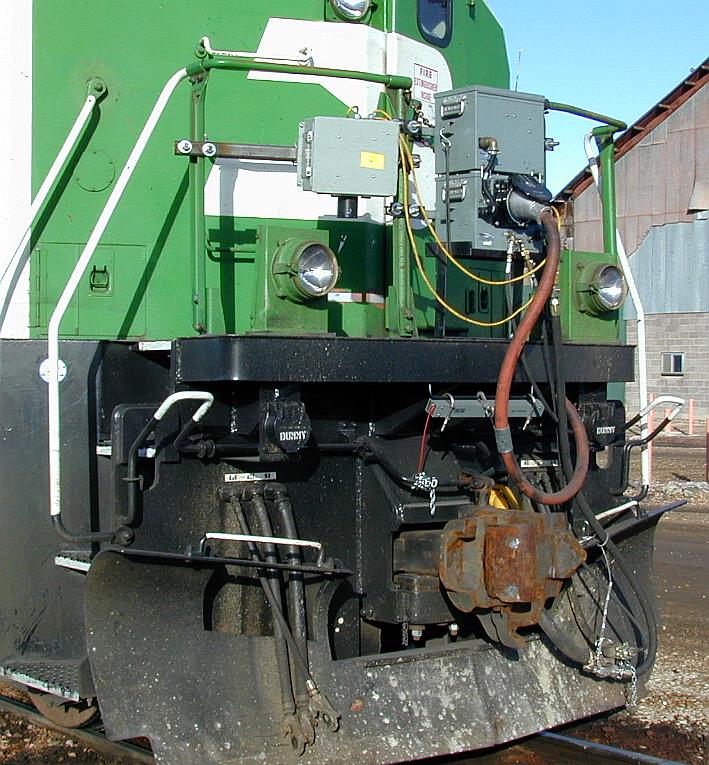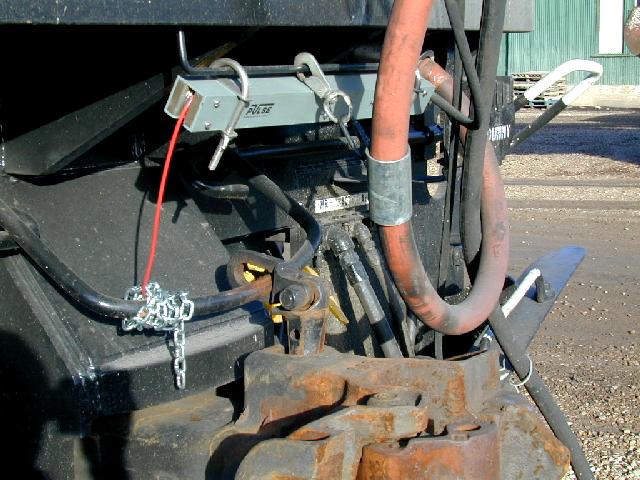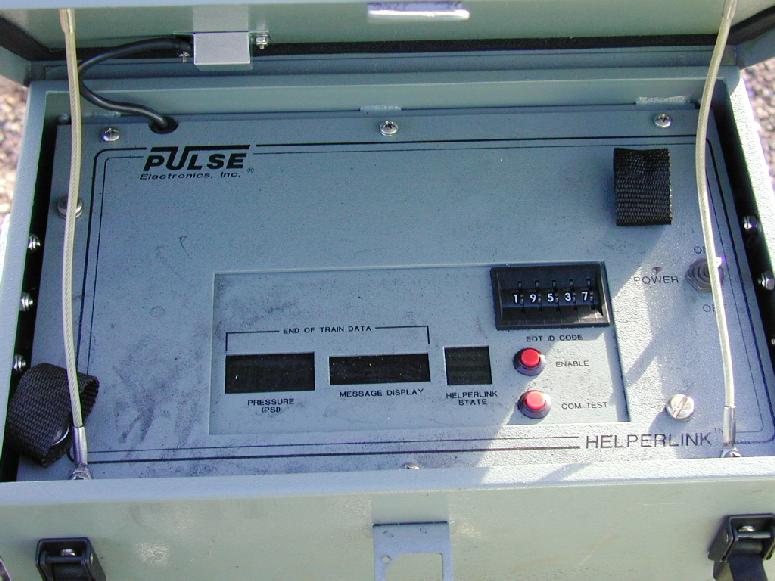
Helper Air Brakes When helpers are going to help a train the air hoses must be coupled between the helper units and the train and the brake valve must be cut out on the helpers. This essentially makes the brakes on the helper units work just like the brakes on a coal car. When the train engineer sets the air brakes on the train the brakes also set on the helpers. Now if the helper engineer is working power at the time the brakes set he should of course actuate off (bale off) the brakes on the helper units since there is no reason to work power against the units' own brakes. As he shoves the train to a stop or slow down he can throttle down gradually being certain to controll the slack as necessary.The main reason for coupling up the air to the helpers though is for emergencies. If the road engineer needed an emergency application of the brakes he also needs the helper units to go into emergency. With the brakepipe coupled to the helpers they will of course go into emergency when the train does. Putting the helper units into emergency causes their brakes to help brake the train but more importantly it kills their power by way of the PCS switch. If you need an emergency application you certainly do not want the helpers to continue shoving you in number 8!
Having the brake pipe coupled to the helpers also allows the helper engineer to put the train into emergency should the helpers derail or other emergency occur. This has happened several times over the decades I've worked at Sheridan. The last time I recall was several years ago when the rail spread on one of the sharp curves at Kiewit and the helper units dropped down between the rails at 45mph on the rear of a coal train. Being dragged along behind a coal train, bouncing over the ties at 45 mph, is not something you want to experience for very long. Obviously in such situations you don't want to call up the road engineer on the head end and ask him to please put the train into emergency. (You might have more seniority than he does and everyone is always looking for a seniority move). You want that train in emergency right now! Knuckles and drawbars be damned. With the air hoses coupled between your helpers and the train all you have to do is place your brake valve into the emergency position. That will put the whole train into emergency, including the head end power. Now all you have to do is hang on and pray that she stays upright until you get stopped. If you are a really good orator you might be able to talk your helper brakeman into going outside and pulling the pin to disconnect you from the coal train but in such situations he usually is too busy clamping his arms to his seat to pay you any heed.
You can see that it is absolutely necessary for the road engineer have braking control of the helper units and for the helper engineer to have braking control of the train. Because the brake pipe air hoses are coupled between the last car of the train being pushed and the helpers you cannot simply pull the pin when the helpers are ready to cut off. If you did so then the helpers and the entire train would go into emergency as the helpers uncoupled and the air hoses parted. So you have to stop the train before you can uncouple the helpers. The helper brakeman must close the anglecock on the helper and close the anglecock on the last car of the train. THEN he can pull the pin and have the helper engineer back away from the train. Since trains use FREDs now you also have to re-couple the FRED air hose to the last car then re-open the anglecock on that last car. (FRED's air hose had been uncoupled when the helpers were originally coupled to the train so the air hose of the train could be coupled to the helper).
As you know, FRED transmits the rear end air pressure to a reciever on the lead locomotive at the head end of the train. That reciever displays the air pressure so the engineer can monitor it. Around here we call those recievers "Marys". Other places call them HOTs HODs, or HEDs (Head of Train Device) and other names. In addition to Mary displaying the air pressure at the last car, which FRED has transmitted to it, the Mary can also send a signal to FRED telling FRED to dump the brake pipe air. Of course when FRED dumps the brake pipe air the entire train goes into emergency, including any helper locomotives.
HELPER LINK Over the past two months or so the BNSF has been equipping our four helper sets (2 units each) at Sheridan, Wyoming with Pulse Corporation's Helper Link equipment. Helper Link allows helpers pushing on the rear end of trains to cut off on the fly instead of first stopping the train being pushed. Because our helper sets push trains going in both directions, both locomotives of each set need to be equipped with Helper Link.So how does Helper Link help? It is very simple, Helper Link provides a "radio air hose". A what? Instead of physically coupling the air hoses between the train's last car and the helpers, the air pressure information is transmitted between the two by radio. All the essential ingrediants are already there, namely the FRED and MARY. All that is really needed is a Mary-like device on the helper to recieve the FRED's air pressure transmissions and operate the helper brakes accordingly. If the air pressure on FRED is 90 psi then the Helper Link recieves this info and puts 90 psi into the helper brake pipe. If the air pressure on FRED drops to 80 psi (a 10 pound set) then the Helper Link reduces the helper brake pipe to 80 psi causing the helper brakes to apply just as if the air hoses were actually coupled. If the air pressure on FRED goes to zero then the Helper Link will reduce the helper brake pipe to zero. And if the FRED recieves an emergency command from the Mary on the lead locomotive of the train then the Helper Link will also put the helpers into emergency.
It works the other way too. If the helper engineer puts his helpers into emergency then the Helper Link sends a radio signal to FRED for it to put the train into emergency. You can see that everything works exactly the same between the train and the helpers air brake-wise as if the air hoses were actually coupled together. But they are not coupled together. In fact you don't even uncouple FRED like you have to do without Helper Link. FRED must remain coupled to the air hose of the last car for Helper Link to function.
With no air hoses coupled between the helper engines and the train there are no anglecocks to close before uncoupling the helper units. So there is no longer any need to stop the train that is being pushed. Just pull the coupler pin and let the helpers drift back away from the train.
To make things a bit safer when uncoupling on the fly the Helper Link device contains a "pin puller". This way the brakeman does not have to get outside on the steps of the moving helper to pull the pin lifter. The helper engineer simply touchtones a code into his communications radio and a Helper Link cylinder actuates to lift the uncoupling pin.
The Helper Link operates the helper brakes by putting air into, or taking air out of, the helpers' brake pipe. Just as if the airhoses were connected to the train. To operate the helper air brakes and the pin lifter cylinder the Helper Link needs a source of compressed air. This is supplied from the helpers' own main reservoirs via a hose connected between the main reservoir equalizing line (a normal MU hose) and the Helper Link control box. Of course another hose connects the Helper Link to the helper locomotive's brake pipe. Electrical power for the Helper Link box is supplied via an MU cable.
The photo below shows the Helper Link equipment on an SD60M at Sheridan.

The next photo is a close up of the pin lifter. The long narrow horizontal box contains the pin lifter cylinder. The piston of the pin lifter pulls on the red cable which in turn pulls the coupler pin via a pulley and chain connection to the locomotive's coupler pin lifter.

The 3rd picture is a view inside the top of the main Helper Link control box. It shows how utterly simple the device is. It has a thumb wheel switch for dialing in the FRED ID code and buttons to arm and test the link to FRED.

The Old Way Progress? Helper Link certainly is safer. But it really does not accomplish anything that hasn't been done since the first helpers were coupled onto the rear end of the first stalled train in the 1800s. Cutting off on the fly was a normal operating practice up until the increased awareness to safety started in the early 1980s.For years and years around Sheridan we routinely uncoupled on the fly. It was a bit easier with cabooses. Cabooses had a chain that hung from the rear platform railing and connected to the pin lifter. A conductor could stand on the platform and pull the pin. Many cabooses also had an extension from the caboose anglecock that came up to the platform railing so the anglecock could be closed without getting down between the caboose and helper. When you reached the top of the hill the train just kept right on moving and the conductor stepped out onto the rear platform, closed the anglecock, and pulled the pin. The helper engineer began throttling down slowly until the caboose pulled away from the helpers. The helpers would of course go into emergency and stop since their anglecock was still open.
Once we got rid of cabooses it got a bit more dangerous. When it came time to cut off, the brakeman would go down the helper loco steps and swing his body around the end of the locomotive. Hanging between the helpers and the last car by one hand the brakeman would reach across the gap and close the anglecock on the last car. He would then reach in front of the helper loco and close the anglecock there also. No need to waste time resettting the helpers emergency application if it can be prevented by closing their anglecock too. All this was often done while bouncing along on bad track at 40 mph or more. Nobody around here was ever hurt doing this but that must be some kind of miracle. The practice of cutting off on the fly was outlawed by the safety rules within a few years of losing the cabooses.
Rules Gurus For those of you who like to study and discuss rules...with Helper Link, what is the maximum speed a train can be traveling when the helpers cut off on the fly? You don't need to see the current safety rules to know the answer to this. You should be able to figure it out for yourself just from general rules.
The answer is: 20 mph (on BNSF).
Why?
Because this is CTC. The instant the helpers uncouple from your train they are a separate train and they are operating in a block into which they have not recieved a signal. This is the same as entering a block from a switch at a point in the middle. Until you get a signal indication you don't know the condition of the block. With Helper Link flying cut offs you actually do know the condition of the block. It is obviously occupied with the train you just cut off of. Therefore the helpers must be operating at restricted speed when cutting off and that means not over 20 mph. If the helpers can't be doing over 20 mph the instant they cut off then neither can the train.
Restricted speed also says be able to stop within one half your range of vision. I haven't quite figured out how you are to manage to stop helpers in 2 inches traveling 18-20 mph the instant you cut off but neither have the officials. Since you obviously are not going to run into the back of the train you just cut off from they look the other way on this subject in the name of "efficiency" and the helpers stop as soon as possible.




| Return to Tales index | My Home Page | E-Mail me |
Created 11-23-2001
Updated 11-23-2001